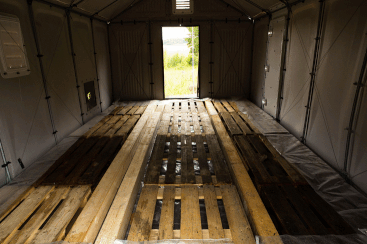You wouldn’t know it if you haven’t visited a refugee camp, but most of those white tents don’t have floors. That goes even for the prefabricated houses. As a result, millions of people live out the most challenging years of their lives subjected to parasitic infections, waterborne ailments, and hypothermia in colder climates. The architects Sam Brisendine and Scott Key first noticed the problem when they were assigned a project to design a temporary relief shelter. They shifted their attention to the floors and eventually devised an elegant design that, importantly, ships well.
Turning the problem into the product
Early on, Sam and Scott stumbled across a parallel problem: supply chains. They needed a way to manufacture and deliver floors to the camps. The team crafted a first design that could be used as both a shipping pallet and a tent floor. Then they hit on a better idea.
Formal refugee camps are often located far from the cities of their host countries, and they require an enormous volume of shipments. Goods are packed on shipping pallets that arrive, but don’t leave. The camps import far more than they export, generating piles of unused shipping pallets as waste.
“We set out to design a raised flooring system that met all of the specific criteria unique to mass sheltering. That means cost-effective, highly mobile, incredibly flexible and above all warm, clean, and comfortable. We call this system the Emergency Floor.”
Subsequent iterations of Sam and Scott’s shelter floor have simplified to harness the wood from unused pallets as support frames for their flooring. The flooring itself is a mat made entirely from post-consumer plastic. It’s designed to fit over a pallet and link together with other mats to connect multiple pallets. The flooring units are modular: they can be attached in different variations to accommodate different housing structures and family sizes.
The result is a lower-cost solution that fits more neatly with existing supply chains. And it also requires fewer partners than their first attempt to create their own pallets.
The Emergency Floor is undergoing its first pilot in rural Sweden in conjunction with a subsidiary of IKEA focused on the shelter relief, where it is affectionately shortened to E-Flör. Later this year, Sam and Scott hope to begin two pilots in refugee camps in Lebanon and Iraq.
We need this
The time for this kind of solution is overdue. There were more than 46 million refugees of concern to the UN High Commissioner for Refugees in mid-2014, the latest date for which there are figures. That marks an increase of 3 million people from just six months earlier at the end of 2013. Although more than half of the world’s refugees are in cities, not camps, four-fifths of them are in developing countries. That could leave tens of millions of people without floors.
Despite a broader shift toward non-tent methods of housing in formal refugee camps, the need has outpaced construction. And snowstorms pounding the Eastern Mediterranean this winter have left tens of thousands of Syrian refugees at risk. Challenges aren’t always volume-based: in the Gaza Strip for example, restrictions on cement import has made it difficult to rebuild housing foundations damaged in conflict.
Profit, not charity
E-Flör has been established as part of a for-profit social enterprise in an effort to sustainably support the manufacturing process required for a physical good. Scott views this element of production as a critical component of their mission.
“Social entrepreneurship means harnessing the principles of capitalism to very explicitly right societal wrongs. It means taking a creative approach to what can be an incredibly destructive force in the world to create permanent, self-sustaining, positive change,” Scott says.
Sam and Scott began their design when both were students at Rice University, and they got off the ground with seed funding and business guidance from Rice’s OwlSpark startup accelerator. For the two of them, the decision to take the project from the classroom to the field was an easy one. “When you see opportunities, doggedly pursue them and finish what you start. The world has far too many unfinished, well-intended projects,” Scott says.


The flooring system for these refugees should be provide comfort and warmth. In some projects we had in the Philippines before where our donors from Rockford IL povided shelters, and free flooring and walling system, I can say that it is necessary to have assessment with what kind of flooring they are comfortable with before doing over like hardwood flooring installation where it isn’t necessary for their case.